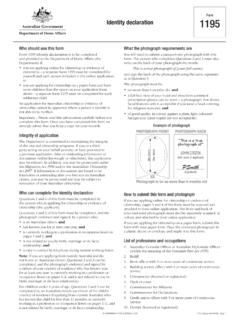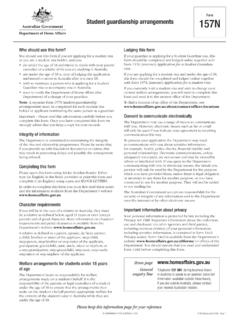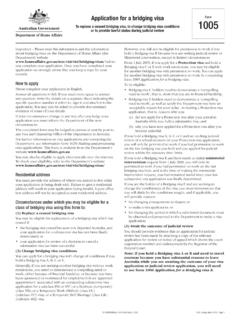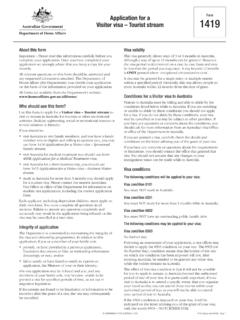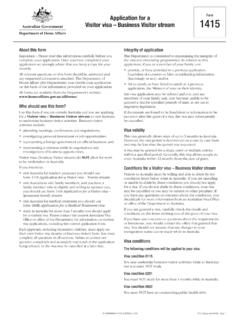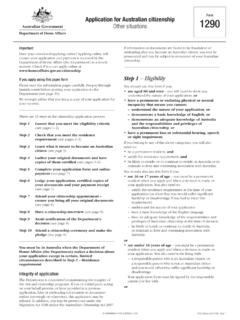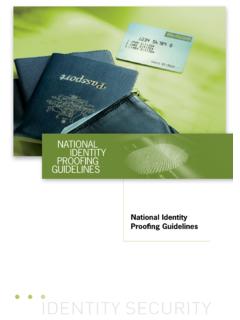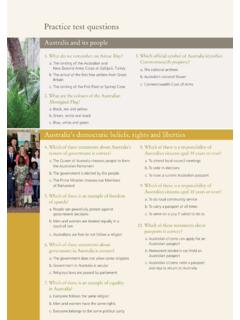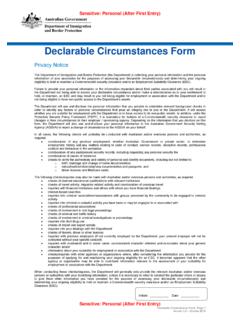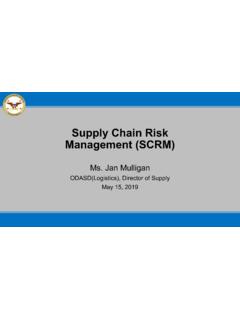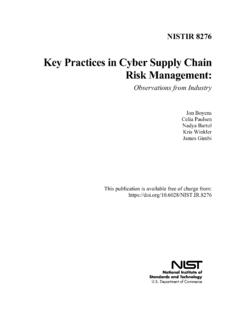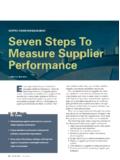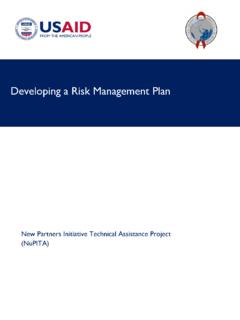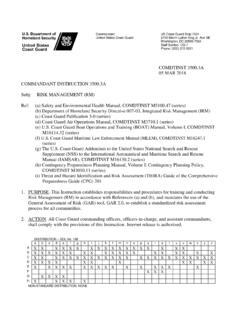Transcription of Risk Management Program Rules - homeaffairs.gov.au
1 OFFICIAL. Risk Management Program Rules Questions, comments or concerns can be emailed to These draft Rules are provided for the purpose of information. They should not be considered final drafted legal instruments. 1. OFFICIAL. OFFICIAL. Risk Management Program Rules 26 November 2021. Contents Context Statement .. 2. Data Hosting Certification .. 5. Definition of Material Risk .. 6. Rule 1 Cyber and information security hazards .. 7. Rule 2 Personnel hazards .. 8. Rule 3 Supply chain 9. Rule 4 Physical and natural hazards .. 10. Attachment A AusCheck explanatory information .. 11. 2. OFFICIAL. OFFICIAL. Context Statement 1. On 29 September 2021 the Parliamentary Joint Committee on Intelligence and Security (the Committee) released its report and supporting recommendations regarding the Security Legislation Amendment ( critical Infrastructure) Bill 2020.
2 2. The Committee made 14 recommendations in relation to the Bill, including proposing a split into two amended bills: a. Bill One was introduced to parliament on 20 October 2021 and includes expanding the critical infrastructure sectors covered by the Security of critical Infrastructure Act 2018, introducing government assistance to be used as a last resort measure as well as mandatory reporting obligations. The Bill as amended was passed by the Senate on 22. November 2021. b. Bill Two will include the declarations of systems of national significance, enhanced cyber security obligations and positive security obligations, which are to be defined in delegated legislation and will require responsible entities for one or more critical infrastructure assets to have, and comply with, a risk Management Program .
3 3. Before making or amending a rule, the Minister for Home Affairs must, among other things, have regard to any existing regulatory system of the Commonwealth, State or a Territory that imposes obligations on responsible entities. Many critical infrastructure sectors already have regulatory systems in place to sufficiently mitigate against threats sufficient to not warrant the development of a risk Management Program . 4. Where an existing regulatory system is not in place, there is a requirement to develop a risk Management Program . 5. A risk Management Program is designed to: Identify each hazard where there is a material risk that the occurrence of the hazard could have a relevant impact on the asset. So far as it is reasonably possible to do so, minimise or eliminate any material risk of such a hazard occurring or mitigate the relevant impact of such a hazard on the asset.
4 6. At its core, a risk Management Program is designed to mitigate risks /hazards that can cause an impact on the functioning of critical infrastructure. For example: a cyber attack resulting in prolonged outages of an electricity provider, a hospital ICU or a payments system;. a terrorist attack on a major liquid fuel pipeline or data centre;. infiltration and sabotage of a major water plant or taking down Australia's domain name systems, or catastrophic failures in food and groceries and freight distribution chains due to a supplier with super user access to systems causing months long outage. 3. OFFICIAL. OFFICIAL. 7. Obligations in Bill Two will require responsible entities to have a written risk Management Program would be switched on via Rules which would include a grace period of at least six months from the making of the Rules or 1 July 2022 whatever is latest.
5 8. These Rules are structured by hazard vector only for the purposes of consultation, ease of discussion and costing. 9. Guidance material will be developed to support the implementation of these Rules . 4. OFFICIAL. OFFICIAL. Data Hosting Certification 1. If a critical data storage or processing asset is Certified Strategic' under the Digital Transformation Agency's Hosting Certification Framework, then, for the purposes of storage of government data and data owned by critical infrastructure clients, that asset is taken to comply with all data storage or processing sector specific Rules . Responsible entities for critical data storage or processing assets are still required to comply with data storage or processing sector- specific Rules for facilities that are not Certified Strategic' under the Hosting Certification Framework, and are still required to comply with risk Management Program obligations under Bill Two.
6 5. OFFICIAL. OFFICIAL. Definition of Material Risk 1. Bill Two will require responsible entities to continue to identify and mitigate material risks that have a substantial impact on the availability, reliability and integrity of a critical infrastructure asset. 2. Responsible entities for critical infrastructure assets must consider all relevant material risks to their business. 3. Responsible entities for critical infrastructure assets are responsible for determining if a risk is a material risk. 4. Recognising the operating context differs between entities, when considering if a risk is a material risk, a risk Management Program should have regard to consideration of: a. impairment of a critical infrastructure asset that may prejudice the social or economic stability of Australia or its people; the defence of Australia or the national security of Australia.
7 B. a hazard that would cause the stoppage or major slowdown of a critical infrastructure asset's functioning for an unmanageable period;. c. the substantive loss of access to or deliberate or accidental manipulation of a component of a critical infrastructure asset such as the position, navigation and timing systems impacting provision of service and/or functioning of the asset;. d. the interference with a critical infrastructure asset's operating technology or information communication technology such as a SCADA system essential to the functioning of a critical infrastructure asset;. e. the relevant impact on the critical infrastructure asset resulting from the storage, transmission or processing of sensitive operational information1 outside Australia;. f. the relevant impact on the critical infrastructure asset resulting from the remote access to operational control or operational monitoring systems of the asset; and g.
8 Any other material risks as identified by the entity that go to the substance of the functioning of a critical infrastructure asset. 1 Sensitive operational information is information about the asset that includes but is not limited to: a. layout diagrams;. b. schematics;. c. geospatial information;. d. configuration information;. e. operational constraints or tolerances information; and f. data that a reasonable person would consider confidential or sensitive about the asset. 6. OFFICIAL. OFFICIAL. Rule 1 Cyber and information security hazards 1. Responsible entities for critical infrastructure assets must, within 6 months of the commencement of this rule, ensure that their risk Management Program includes details of a risk-based plan that outlines strategies and security controls as to how cyber and information security threats are being mitigated.
9 2. Responsible entities for critical infrastructure assets must, within 18 months of the commencement of this rule, ensure that their risk Management Program includes details of how the responsible entity complies with at least one of the following standards and frameworks: a) The Australian Cyber Security Centre's Essential Eight Maturity Model at maturity level one;. b) AS ISO/IEC 27001:2015;. c) The National Institute of Standards and Technology (NIST) Cybersecurity Framework;. d) The Cybersecurity Capability Maturity Model (C2M2) at Maturity Indicator Level 1;. e) Security Profile 1 of the Australian Energy Sector Cyber Security Framework; or f) an equivalent standard. 7. OFFICIAL. OFFICIAL. Rule 2 Personnel hazards 1. Responsible entities for critical infrastructure assets must, within 6 months of the commencement of this rule, ensure that their risk Management Program includes details of how the entity identifies their critical positions2 and/or critical personnel3 and includes a list of these positions and/or personnel, as appropriate.
10 2. Responsible entities for critical infrastructure assets must, within 6 months of the commencement of this rule, ensure that their risk Management Program includes details of how the entity ensures that the suitability of critical positions and critical personnel are appropriately managed, including but not limited to: a) assessing and managing the ongoing suitability of critical personnel and persons holding critical positions, through personnel and human resource arrangements; and b) considering, where commensurate with the risk environment, requiring an AusCheck4 or an equivalent vetting check for critical personnel. 3. Responsible entities for critical infrastructure assets must, within 6 months of the commencement of this rule, ensure that their risk Management Program includes details of how the entity manages risks arising from potential negligent personnel and malicious insiders who could cause damages to the functioning of a critical infrastructure asset.

